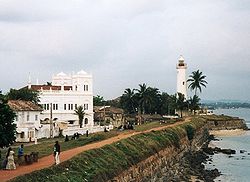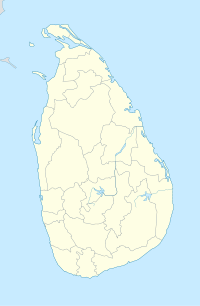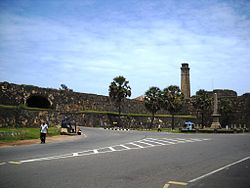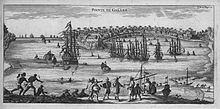- Galle
-
For other uses, see Galle (disambiguation).
Galle
ගාල්ල
காலி— City — Center of Galle City Coordinates: 6°3′0″N 80°13′0″E / 6.05°N 80.216667°E Country  Sri Lanka
Sri LankaProvince Southern Province Government – Mayor Methsiri de Silva Area – Total 1,652 km2 (637.8 sq mi) – Land 1,617 km2 (624.3 sq mi) – Water 35 km2 (13.5 sq mi) Population (2001) – Total 90,934 – Density 613/km2 (1,587.7/sq mi) Time zone Sri Lanka Standard Time Zone (UTC+5:30) Old Town of Galle and its Fortifications * UNESCO World Heritage Site

Country Sri Lanka Type Cultural Criteria iv Reference 451 Region ** Asia-Pacific Inscription history Inscription 1988 (10th Session) * Name as inscribed on World Heritage List
** Region as classified by UNESCOGalle (Sinhala: ගාල්ල;Tamil: காலி) (pronounced as one syllable in English, /ˈɡɔːl/ "Gaul", and as two in Sinhalese, [ɡaːlːə]) is a city situated on the southwestern tip of Sri Lanka, 119 km from Colombo. Galle is the capital city of Southern Province of Sri Lanka and it lies in Galle District.
Galle was known as Gimhathiththa (although Ibn Batuta in the 14th century refers to it as Qali[verification needed]) before the arrival of the Portuguese in the 16th century, when it was the main port on the island. Galle reached the height of its development in the 18th century, during the Dutch colonial period. The major river is Gin River (Gin Ganga) which starts from Gongala Kanda and passing villages such as Neluwa, Nagoda, Baddegama, Thelikada, and Wakwella, reaches the sea at Ginthota. In Wakwella over the river there is Wakwella Bridge, which is the longest bridge in Sri Lanka.
Galle is the best example of a fortified city built by Europeans in south and southeast Asia, showing the interaction between European architectural styles and south Asian traditions. The Galle fort is a world heritage site and the largest remaining fortress in Asia built by European occupiers. Other prominent landmarks in Galle include the natural harbor, the National Maritime Museum, St. Mary's Cathedral founded by Jesuit priests, one of the main Shiva temples on the island, and Amangalla the historic luxury hotel.
Galle is the main city in the most southerly part of the island, with a population of around 100 000, and is connected by rail to Colombo and Matara. On 26 December 2004 the city was devastated by the massive Boxing Day Tsunami caused by the 2004 Indian Ocean earthquake that occurred a thousand miles away, off the coast of Indonesia. Thousands were killed in the city alone. Galle is home to a cricket ground, the Galle International Stadium, rebuilt after the tsunami. Test matches resumed there on December 18, 2007.
Rumassala in Unawatuna is a large mound-like hill, which forms the eastern protective barrier to the Galle harbour. Local tradition associates this hill with some events of the Ramayana.
Contents
History
According to James Emerson Tennent, Galle was the ancient seaport of Tarshish, from which King Solomon drew ivory, peacocks and other valuables.
Cinnamon was exported from Sri Lanka as early as 1400 BC and the root of the word itself is Hebrew, so Galle may have been a main entrepot for the spice.[citation needed]Galle had been a prominent seaport long before western rule in the country. Persians, Arabs, Greeks, Romans, Malays, Indians, and Chinese were doing business through Galle port. In 1411, the Galle Trilingual Inscription, a stone tablet inscription in three languages, Chinese, Tamil and Persian, was erected in Galle to commemorate the second visit to Sri Lanka by the Chinese admiral Zheng He.
The "modern" history of Galle starts in 1505, when the first Portuguese ship, under Lourenço de Almeida was driven there by a storm. However, the people of the city refused to let the Portuguese enter it, so the Portuguese took it by force.
In 1640, the Portuguese had to surrender to the Dutch East India Company. The Dutch built the present Fort in the year 1663. They built a fortified wall, using solid granite, and built three bastions, known as "Sun", "Moon" and "Star". After the British took over the country from the Dutch in the year 1796, they preserved the Fort unchanged, and used it as the administrative centre of Galle.
Governance
The Galle Municipal Council governs the City of Galle. It was established under the Municipalities Ordinance of 1865. The first mayor of Galle was Wijeyananda Dahanayake, who was appointed in 1939. He later became the Prime Minister of Ceylon. The current Mayor of Galle is Methsiri de Silva, who was appointed on December 4, 2008. The main vision of Galle City is "Building of moderate city through the supply of relatively increased utility services to the citizens who pay taxes to the Municipal council [1]. The other vision is to brand Galle as "GreenCity-Greengalle [2]" to create and promote Galle as Sri Lanka's cool and healthy coastal city with clean green canopy. This is a historical place in Sri Lanka.
Climate
Galle features a tropical rainforest climate. The city has no true dry season, though it is noticeably drier in the months of January and February. As is commonplace with many cities with this type of climate, temperatures show little variation throughout the course of the year. Average temperatures hovers at around 26 degrees Celsius throughout the year.
Month Jan Feb Mar Apr May Jun Jul Aug Sep Oct Nov Dec Year Avg Temp °C
(°F)25
(77)26
(78)27
(80)27
(80)27
(80)27
(80)26
(78)26
(78)26
(78)26
(78)26
(78)25
(77)26
(78)Precipitation centimeters
(inches)10.2
(4)8.6
(3.4)11.7
(4.6)24.1
(9.5)29.7
(11.7)20.6
(8.1)16.5
(6.5)15.5
(6.1)21.3
(8.4)34.0
(13.4)30.2
(11.9)17.8
(7)240.3
(94.6)source: Weatherbase
Demographics
Galle is a sizeable city, by Sri Lankan standards, and has a population of 91 000, the majority of whom are of Sinhalese ethnicity. There is also a large Sri Lankan Moor minority, particularly in the fort area, who descend from Arab merchants that settled in the ancient port of Galle. Galle is also notable for its foreign population, both residents and owners of holiday homes.
Ethnicity Population % Of Total Sinhalese 66,114 72.70 Sri Lankan Moors 23,234 25.55 Sri Lankan Tamils 989 1.09 Indian Tamils 255 0.28 Other (including Burgher, Malay) 342 0.38 Total 90,934 100 Source: 2001 Census
Education
Schools
Main article: List of schools in Sri LankaGalle is home to some of the oldest and leading schools in Sri Lanka. 29 government schools and 5 international schools are situated in Galle. All the government schools provide free education to the children. Some of the schools situated in Galle city are listed below.
- Richmond College
- Mahinda College
- St. Aloysius' College
- Vidyaloka College
- All Saints College
- Malharus Sulhiya College
- Southlands College
- Sanghamitta Girls College
- Sacred Heart Convent
- Rippon Girls' College
- Anula Devi Balika Vidyalaya
- Muslim Ladies College
- Siridhamma College
- Olcott Vidyalaya
- Sudharma Vidyalaya
- Leeds International School
- Ceylinco Sussex College
- Kingston International School
- Thomas Gall International School
Universities
Two main faculties of University of Ruhuna are located in Galle. The Faculty of Engineering is located at Hapugala about 5 km from the city center. The faculty of Medicine is located at Karapitiya near the Karapitiya Teaching Hospital. The Medical faculty is also located at about 5 km from the city center. A study centre of the Open University of Sri Lanka is also located in Galle at Labuduwa junction.
- Faculty of Engineering
- Faculty of Medicine
- Study Centre of the Open University of Sri Lanka
Higher Education Institutes
Advanced Technological Institute in Labuduwa, Galle was started in year 2000 and it was planned to offer Higher National Diploma in Information Technology - HNDIT and Higher National Diploma in Agriculture Technology - HNDT (Agri). Since then Labuduwa ATI has been a pioneer in technological education in Sri Lanka. National Institute of Business Management in Galle was established in 2010 to provide higher education opportunities in the fields of Information Technology and Business Management.
- Advanced Technological Institute (ATI)
- National Institute of Business Management (NIBM)
Twin cities
 View of the Galle International Cricket Stadium from the dutch fort in Galle.
View of the Galle International Cricket Stadium from the dutch fort in Galle.
The City of Galle is twinned with:
Country City State / Region Since  Netherlands
Netherlands Velsen
Velsen North Holland
North Holland1988 Although not an official twin city,
 Melbourne, Australia 'adopted' Galle after the 2004 tsunami disaster, funding the reconstruction of its cricket ground and providing financial and other support.
Melbourne, Australia 'adopted' Galle after the 2004 tsunami disaster, funding the reconstruction of its cricket ground and providing financial and other support.Gallery
See also
References
- Galle Municipal Council
- A Historic tour through the city of Galle
- The old world's romantic city: Galle!
- Galle - A Port City in History
- Galle Shipwreck's (Article from Divaina)
- Galle harbour (Article from Divaina)
- Discover Sri Lanka - More information & images on Galle and Galle Fort
- Discover Sri Lanka - More information & images on Physical and historical Position of Galle
External links
- GalleLink ,The Way of Galle - More information about Galle
- Old Town of Galle and its Fortifications, UNESCO World Heritage
- Galle Fort hotel
- Official website of the Sri Lanka Tourism Board
- Corridors of Oceanic Heritage: The Maritime Archaeology Museum, Galle
Urban councils of Sri Lanka Ambalangoda · Ampara · Anuradhapura · Balangoda · Bandarawela · Beruwala · Boralesgamuwa · Chavakacheri · Chilaw · Dehiwala-Mount Lavinia · Embilipitiya · Eravur · Gampola · Hambantota · Haputale · Hatton-Dickoya · Hikkaduwa · Horana · Ja-Ela · Kadugannawa · Kalutara · Kattankudi · Katunayaka-Seeduwa · Kegalle · Kesbewa · Kinniya · Kolonnawa · Kuliyapitiya · Maharagama · Mannar · Minuwangoda · Monaragala · Mullaitivu · Nawalapitiya · Panadura · Peliyagoda · Point Pedro · Polonnaruwa · Puttalam · Seethawakapura · Tangalle · Talawakele-Lindula · Trincomalee · Valvettithura · Vavuniya · Wattala-Mabola · Wattegama · WeligamaCities in Sri Lanka Capitals 
Other cities Anuradhapura · Badulla · Batticaloa · Dehiwala-Mount Lavinia · Galle · Hambantota · Jaffna · Kandy · Kurunegala · Maharagama · Matara · Moratuwa · Negombo · Nuwara Eliya · Polonnaruwa · Ratnapura · TrincomaleeProvincial capitals of Sri Lanka Colombo · Kandy · Galle · Jaffna · Trincomalee · Kurunegala · Anuradhapura · Badulla · Ratnapura

World Heritage Sites in Sri Lanka Anuradhapura · Central Highlands · Galle and its Fortifications · Golden Temple of Dambulla · Kandy · Polonnaruwa · Sigiriya · Sinharaja Forest Reserve
Coordinates: 6°02′02.97″N 80°12′58.77″E / 6.0341583°N 80.216325°E
Categories:- World Heritage Sites in Sri Lanka
- Galle
- Provincial capitals in Sri Lanka
Wikimedia Foundation. 2010.














